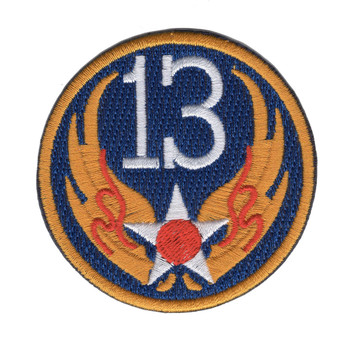Description
5th Air Force Shoulder Patch (U.S. Air Force) 2.5" x 2.5" Embroidered Patch with Iron-On Backing
Superior Materials: Made with premium polyester thread and durable twill fabric, ensuring long-lasting color and strength.
Advanced Embroidery Technology: Crafted using the most advanced embroidery machinery, guaranteeing intricate detail, sharp lines, and consistent quality every time.
Easy Iron-On Application: Features a heat-activated adhesive backing for quick, no-sew attachment. Simply position, iron, and press for a secure bond.
Versatile Use: Perfect for personalizing jackets, backpacks, uniforms, or any fabric surface that needs a touch of personality.
Durable and Washable: Designed to withstand everyday wear and occasional washing without fading or fraying.
Formations & Origins
The 5th Air Force is one of the oldest and most storied numbered air forces in the United States Air Force. It was originally activated as the Philippine Department Air Force in 1941, just months before the outbreak of World War II in the Pacific. Following the Japanese attack on Pearl Harbor and the invasion of the Philippines, it was redesignated the Far East Air Force, and later the 5th Air Force. Its primary mission was to provide air defense of the Philippines and support ground forces during the brutal early months of the Pacific War. Over the decades, the 5th Air Force evolved into a key strategic and tactical air force, playing a vital role in every major conflict in the Asia-Pacific region.
The distinctive shoulder patch features a blue shield with a white star and red circle in the center, flanked by gold wings extending upward. The star and circle evoke the classic USAAF roundel, symbolizing American air power, while the gold wings represent flight and speed. This patch is a badge of honor worn by airmen who serve in one of the Air Force’s most forward-deployed commands.
Notable Commanders
One of the most famous commanders of the 5th Air Force was General George C. Kenney, who led the force during the critical campaigns in New Guinea and the Philippines in World War II. Known for his innovative tactics and aggressive airpower use, Kenney transformed the 5th Air Force into a potent strike force that supported Allied advances across the Pacific. His leadership helped pioneer the use of fighter-bombers and close air support, setting the standard for modern air warfare.
Another significant leader was General Curtis LeMay, who served with the 5th Air Force early in his career and would go on to command the Strategic Air Command during the Cold War, shaping the United States’ nuclear deterrence strategy.
Major Campaigns/Operations
The 5th Air Force’s combat history is rich and varied. In World War II, it was heavily engaged in the defense and eventual liberation of the Philippines, conducting bombing raids, air superiority missions, and close support for ground troops battling entrenched Japanese forces. It was instrumental in campaigns across New Guinea, the Solomon Islands, and later in Borneo.
During the Korean War, the 5th Air Force provided relentless air support for United Nations ground forces, flying thousands of combat sorties in harsh winter conditions. It conducted interdiction missions to cut off North Korean supply lines and provided close air support during pivotal battles such as the Pusan Perimeter and the Inchon landing.
Throughout the Vietnam War, the 5th Air Force’s units participated in air defense and combat operations over Southeast Asia, flying from bases in Japan and South Korea. Today, it remains a key part of U.S. air operations in the Indo-Pacific, supporting regional security, joint exercises, and rapid response missions.
Specialized Role/Equipment
The 5th Air Force serves as the United States Air Force’s forward-deployed command in the Pacific, responsible for air operations in Japan and South Korea. It is a multi-role force comprising fighter, bomber, reconnaissance, airlift, and refueling units, working closely with allied air forces. Its mission includes air superiority, rapid strike, close air support, intelligence gathering, and logistical support.
Over time, the force has operated a wide range of aircraft—from World War II-era P-38 Lightnings and B-25 Mitchell bombers, to Cold War jets like the F-86 Sabre and F-4 Phantom, to modern fighters such as the F-15 Eagle and F-35 Lightning II. The 5th Air Force is also integral in ballistic missile defense and space-based reconnaissance efforts.
Acts of Heroism
The 5th Air Force has countless stories of heroism spanning multiple wars. One example is the extraordinary bravery of the pilots and crews who flew hazardous missions during the Battle of the Philippines in 1941-42. Many aircraft were outnumbered and outgunned but flew continuous sorties under fire, often returning with severe damage to save ground forces.
During the Korean War, aircrews risked their lives flying low-level attacks against heavily defended targets, often in the face of intense anti-aircraft fire and challenging weather. Their courage was pivotal in halting enemy advances and protecting allied troops.
In recent decades, 5th Air Force personnel have taken part in humanitarian missions and disaster relief in the Pacific region, demonstrating valor not only in combat but in service to those in need.
Legacy & Notable Achievements
The 5th Air Force’s legacy is one of relentless dedication, innovation, and strategic importance in the Pacific theater. It was at the forefront of turning the tide against Japan in World War II, a cornerstone of United Nations air power in Korea, and a key player in Cold War deterrence and regional stability.
The 5th Air Force remains one of the Air Force’s most critical commands, symbolizing American commitment to security and partnership in Asia. Its shoulder patch is a mark of pride, worn by airmen who uphold a tradition of excellence in some of the world’s most challenging and dynamic environments.
To serve in the 5th Air Force is to be part of a living history—an enduring testament to airpower’s decisive role in shaping global events.


















